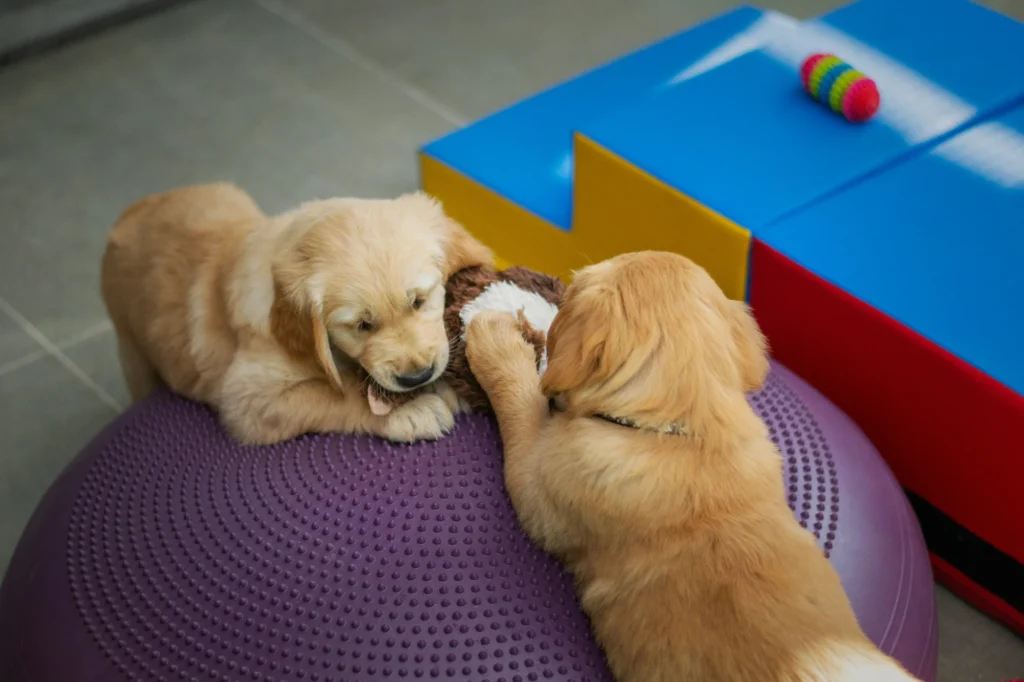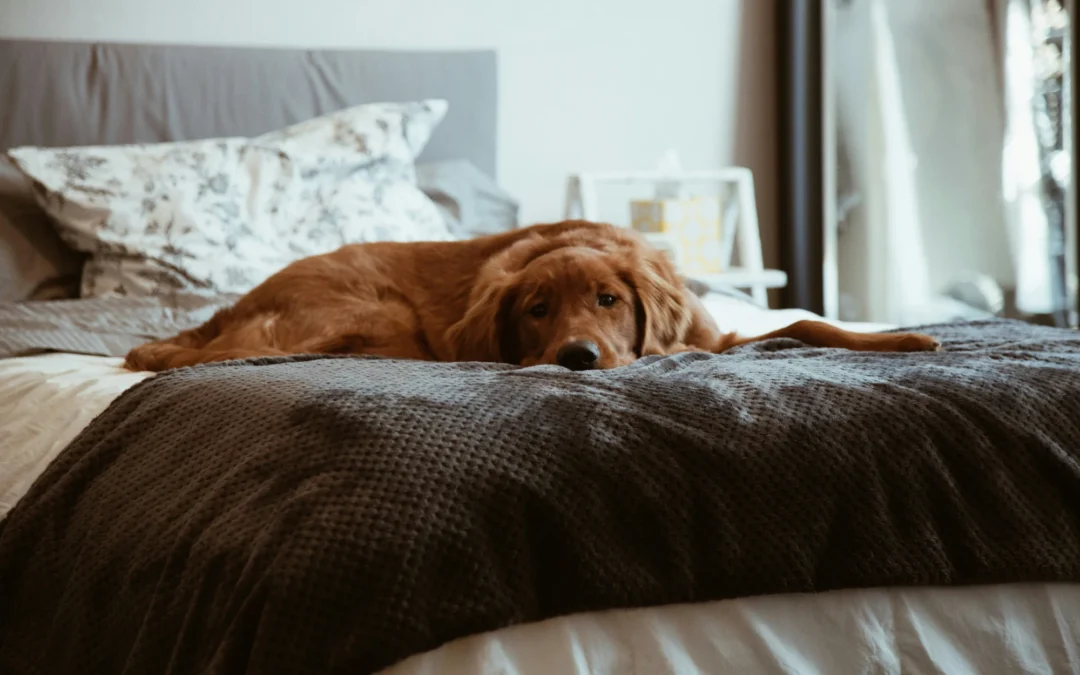How Long Can a Dog Stay Home Alone: Quick Summary
- Most healthy adult dogs can stay home alone for 4–8 hours, depending on their age, health, and energy level.
- Puppies and senior dogs need more frequent bathroom breaks, care, and attention.
- Signs your dog is lonely or bored include barking, chewing, pacing, or accidents indoors.
- Create a routine with exercise, mental stimulation, and comfort to make alone time easier.
- Consider dog daycare or boarding at DogPlay for peace of mind when you’re away.
Every dog parent asks it at some point: how long can a dog stay home alone before it becomes too long? Whether you’re working a full day, running errands, or out for the evening, finding that balance between independence and companionship is key to a happy, well-adjusted dog. Most dogs can handle short absences, but extended periods of solitude can lead to boredom, stress, or even separation anxiety in dogs when left alone.
At DogPlay, we know your dog isn’t “just a pet”—they’re family. That’s why we provide personalized daycare, overnight boarding, and grooming for dogs across Vancouver. If you’re wondering what’s best for your schedule and your pup’s wellbeing, here’s everything you need to know (and how we can help).
How Long Can a Dog Stay Home Alone?
There’s no single rule for how long a dog can stay home alone, because every dog’s needs are different. Still, veterinarians generally agree that healthy adult dogs can manage around 4–8 hours of alone time before they need a break, companionship, or mental stimulation. Puppies and seniors, on the other hand, require more frequent care.
Leaving your dog alone longer than this can increase anxiety, cause accidents, or lead to destructive behaviour. If you’re routinely leaving your dog home alone while at work, consider options like a trusted friend, a midday walk, or professional daycare to make the day easier for both of you.
What Factors Affect How Long a Dog Can Stay Home Alone?
Age and Bladder Control
A dog’s ability to hold their bladder depends largely on age. Puppies under six months usually need a bathroom break every 2–3 hours, while healthy adult dogs may last 4–8 hours, depending on their size, health, and routine. Seniors often revert to needing more frequent outings. For pet parents who use pee pads, they can help prevent accidents, especially for puppies or older dogs, but outdoor walks are still essential for exercise and mental stimulation. For long workdays, hiring a trusted dog walker or pet sitter can help provide those essential breaks when you can’t be home. Daycare is another great option to ensure your dog gets timely potty breaks, companionship, and exercise instead of being cooped up all day.
Breed and Energy Level
Energy and temperament make a huge difference. Independent, low-energy breeds like Basset Hounds or Bulldogs may relax while alone. But working breeds—Border Collies, Huskies, Retrievers—often get restless, needing outlets for their energy. Knowing how long a dog can stay alone at home depends as much on breed traits as daily routine.

Health and Temperament
A healthy dog might nap quietly during your absence, while one with arthritis, separation anxiety, or medical needs might struggle. Dogs with anxiety especially benefit from structured environments like daycare, where social play and supervision replace idle hours alone.
For dogs managing health conditions—such as high blood pressure, epilepsy, pain or inflammation, diabetes, or even a temporary round of antibiotics—consistent care and timely medication matter just as much as companionship. At DogPlay, our team is trained to administer and log all medications free of charge, following clear owner instructions. We believe no dog (or human) should be penalized for needing a little extra care—your pup’s wellbeing always comes first.
Environment and Routine
A predictable routine gives your dog a sense of stability. Leaving toys, background music, or even using a pet camera to check in can make alone time easier. If your dog has a companion, they may comfort each other, but they’ll still crave daily human interaction and exercise. Nothing replaces social engagement, so if your schedule varies, balance home-alone days with daycare visits, where your dog’s day stays active, social, and consistent.
How Long Can Dogs Stay Home Alone by Age?
Puppies (Under 6 Months)
Leaving a puppy home alone for more than 2–3 hours can lead to stress, accidents, and missed training opportunities. Puppies need frequent potty breaks and human contact to develop healthy habits. A few half-days at daycare can help your puppy build social skills, confidence, and structure while you work or run errands.
Adult Dogs (1–7 Years)
How long can you leave an adult dog home alone? Most adult dogs can comfortably handle around 4–6 hours. Some adapt to 8 hours if they get enough exercise and stimulation before and after. If your workday runs long, consider splitting their day with a daycare visit or dog walker.
Senior Dogs (7+ Years)
Age affects every dog differently depending on size, breed, and health. While some older dogs nap more or move at a gentler pace, many stay active and playful well into their senior years. Most healthy senior dogs can comfortably stay home alone for about 4–8 hours, similar to younger adults, especially if they’re used to your daily routine and have easy access to water, food, and a cozy place to rest.
However, dogs with mobility issues, incontinence, or anxiety may need shorter stretches alone—around 2–4 hours—and more frequent breaks. If you notice changes in your dog’s energy, bladder control, or comfort level, it may be time to shorten their solo time or provide extra care.
Signs Your Dog Is Lonely or Bored
When dogs spend too much time alone, they can show it in their behaviour. Common signs your dog is lonely or bored include excessive barking, destructive chewing, pacing, clinginess, or having accidents indoors. Some may eat less or sleep more when they feel isolated—though any sudden change in appetite, energy or toileting should also prompt a check-in with your vet.
How to Make Alone Time Easier for Your Dog
Not every dog parent can be home all day, but there are ways to make time apart more comfortable for your pup:
- Exercise before you leave: A long morning walk or play session helps burn energy.
- Provide mental stimulation: Puzzle feeders and toys keep your dog occupied.
- Create a safe, calm space: Leave soft music playing, provide cozy bedding, and keep a consistent routine.
- Let in natural light and fresh air: Open blinds so your dog can enjoy daylight or look outside if it helps them relax. A slightly open, secure window with a screen can provide gentle ventilation — just make sure it’s safe and that outside activity doesn’t overstimulate them.
- Check in midday: If you’re leaving your dog home alone while at work, arrange for a trusted walker or a visit to daycare.

When to Consider Doggy Daycare or Boarding
If your schedule keeps you consistently away for much of the day or your dog shows anxiety, boredom, or health needs that require supervision, daycare or boarding can make a world of difference. Dogs thrive on structure, activity, and connection, something DogPlay naturally provides.
Our daycare programs offer safe, enriching days filled with play, naps, and socialization under constant supervision. For dogs requiring regular medication, our experienced staff carefully follow your instructions and record every dose at no extra charge, so you can enjoy peace of mind knowing your pet’s routine stays on track.
For longer absences, our boarding suites provide a calm, comfortable stay with staff onsite 24/7—something few facilities in Vancouver offer. Whether your dog needs extra cuddles, timely medication, or just a fun-filled day, DogPlay ensures they’re cared for like family.
How Long a Dog Can Stay Home Alone FAQs
Can I leave my dog home alone for 8 hours?
Eight hours is the upper limit for most dogs, and even then, only if they’ve exercised and have bathroom access. If you’re gone that long daily, consider alternating daycare days to avoid loneliness.
Should I get a dog if I work 10 hours a day?
Owning a dog with a long work schedule is possible but requires planning. Daycare, dog walkers, or friends who can help break up the day make a big difference.
How can I tell if my dog has separation anxiety?
Signs include destructive chewing, pacing, whining, or accidents right after you leave. A consistent routine, plenty of exercise, and social time at a trusted dog daycare in Vancouver like DogPlay can help ease that anxiety and build your dog’s confidence when alone.
What breeds handle being alone best?
Breeds like French Bulldogs, Chow Chows, Basset Hounds, and Pugs tend to be more adaptable to solitude. They’re typically calm and independent, making them comfortable with moderate alone time. In contrast, working breeds—such as Border Collies, Australian Shepherds, Labrador Retrievers, and German Shepherds—usually need more activity and interaction. These dogs thrive on having a job or purpose, so long solo days can lead to restlessness or destructive behaviour.
What can I do if I work long hours but have a dog?
Break up the day with a dog walker or dog daycare sessions. Even a few hours of activity can dramatically improve your dog’s wellbeing.
Is dog daycare worth it for my dog?
Absolutely. Daycare builds social skills, prevents stress, and helps your dog return home relaxed and fulfilled.
Schedule a Trial Day With DogPlay Today
Ready to give your dog happier, more fulfilling days? At DogPlay, we offer personalized daycare, boarding, and grooming to fit your schedule and your dog’s needs. Experience peace of mind knowing your dog is loved, supervised, and socialized while you’re away. Register today for a trial day and discover why Vancouver dog parents trust DogPlay year-round.
For more pet care tips, visit our blog.

